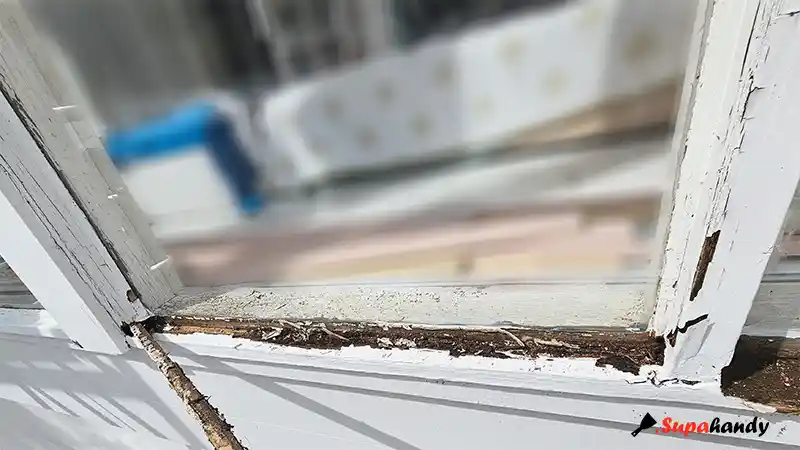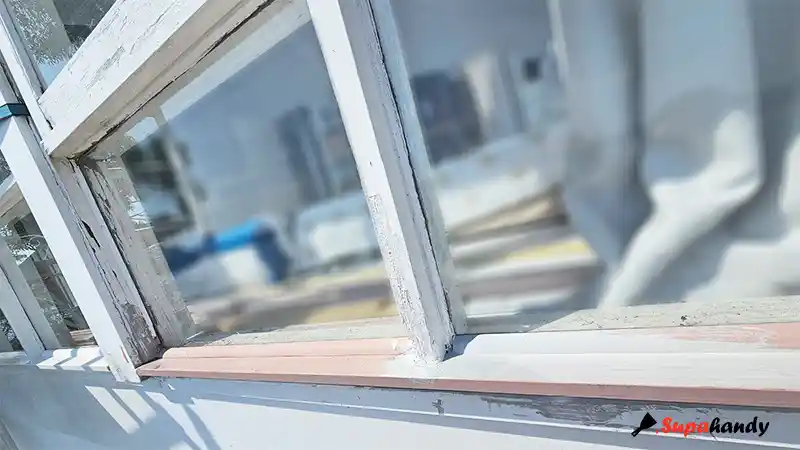Introduction to Repair Rotted Window Frame
A rotted window frame is more than just an eyesore — it can lead to serious issues if left untreated. Exterior window frames affected by rot can leak during rain, causing damage to surrounding structures, compromising insulation, and even weakening your property’s overall security.
Whether the rot is due to prolonged moisture exposure, lack of maintenance, or simple aging, addressing the problem early can save you the cost of a full window replacement, or even the cost of repairing the full section property.
In this guide, we’ll walk you through the steps to repair a rotted exterior timber window frame and restore its strength and appearance yourself.

Why Do Window Frames Rot?
The most common reasons caused rotted windows frame include:
- Peeled off paint, or missed glazing putty, allowing water to seep and be trapped inside wood joints.
- Excess moisture from rain, humidity, or leaks is trapped inside joints or behind frames.
- Poor ventilation, trapping moisture in the frame joints for a longer time.
- Old or untreated wood, making it more susceptible to decay.
- Poor drainage.
- Nature wear and lack of regular maintenance.
Tools & Materials to Repair Rotted Window Frame
Before starting the repair, gather the following materials:
- Screwdriver, chisel, hammer, oscillating multi-tool
- Wood hardener, wood putty, and putty knife
- Matching exterior H3 treaded pine FJ, like 18x42mm 4 Edges Pencil Round Moulding
- Sandpaper (80-150 grit), paint primer, exterior paint, and paintbrush
- Safety gloves and goggles
Step-by-Step Guide to Repair Rotted Window Frame
Step 1: Assess the Damage
Start by pressing a screwdriver into the window frame timber to assess how deep the rot has spread. If the damage is only surface-level and the wood still feels firm underneath, you can repair it using wood hardener and filler or putty. However, if the wood is soft and crumbles deeply, it indicates more severe rot – in that case, cutting out and replacing the damaged section of the window frame will be necessary.
Step 2: Remove the Rotted Wood Frame
Use a chisel or an oscillating multi-tool to carefully scrape out all the decayed wood from window frame. Make sure to remove every bit of soft, damaged material until you reach solid, healthy timber. This step is essential to ensure a strong and lasting repair to the window frame.
Step 3: Apply Wood Hardener (For Minor Rot)
If the remaining timber is still structurally sound but feels soft, apply a wood hardener to strengthen and stabilize the window frame. This helps prevent further decay and creates a solid base for filler or repair. Be sure to follow the manufacturer’s drying time and application instructions for best results.
Step 4: Fill the Gaps with Wood Putty
Mix an exterior-grade wood putty according to the manufacturer’s instructions and use a putty knife to apply it to the damaged areas. Shape the putty to match the original frame profile, smoothing it out as needed. Allow the putty to cure overnight to ensure a firm, durable repair.
Step 5: Sand the Surface
Once the putty has fully cured, use 80-150 grit sandpaper to smooth the repaired area. Sand gently to ensure the surface is even and blends well with the surrounding window frame. After sanding, wipe away any dust with a blower or a damp cloth to ensure a clean, dust-free surface on window timber frame before painting.
Step 6: Prime and Paint
To prevent water infiltration, seal any gaps between the timber joints using an exterior-grade filler. Once the gaps are sealed, apply an exterior wood primer to protect the repair and ensure better paint adhesion. After the primer has dried, apply at least two coats of weather-resistant exterior paint to the window timber frame for long-lasting protection against rains or sun.
Notes: As to old windows, we recommend applying oil-based primer before applying water-based weather paint. Please refer to our previous blog: Water or Oil-Based Paint: Which Is Right for Woodwork Painting for detailed instructions.

Replacing Severely Rotted Sections
If the damage is extensive, cutting out and replacing it is necessary:
- Use a multi-tool or hand saw to carefully cut out the rotted section of the frame. Remove any exposed nails with a hammer or pry bar.
- Cut a new piece of H3 timber that matches the original profile and dimensions of the removed section.
- Secure the new piece in place using exterior-grade wood glue and galvanized nails.
- Install an H3-treated timber quad or a 10–18mm square timber moulding to cover any joints or gaps between the glass and the timber frame.
- Fill all remaining gaps and nail holes with an exterior-grade gap filler. Once dry, sand the surface smooth, apply a primer, and finish with exterior paint to protect the timber from future moisture damage.
Notes:
- Always ensure the window sill has a slight downward slope away from the window. This allows rainwater to drain off quickly instead of pooling and soaking into the timber.
- Before securing the replacement timber, apply a layer of exterior-grade silicone sealant underneath. This adds an extra barrier against moisture and improves the waterproofing at the joints, helping to extend the life of the repair.
Preventing Future Window Frame Rot
To keep your window frames in good condition and avoid rot from returning, follow these key maintenance tips:
- Regularly apply a quality exterior paint or wood sealant to protect the timber from moisture and UV damage.
- Check your window frames for signs of damage such as cracks, peeling paint, soft spots, or leaks. Early detection and repair can prevent costly repairs later.
- Make sure the area around your windows allows water to drain away easily. Avoid any blockages or obstructions that can trap moisture.
- Apply exterior-grade caulk to any gaps or joints around the frame to prevent water from seeping in and causing hidden damage.
Final Thoughts: How to Repair Rotted Window Frame
Repairing a rotted window frame is a crucial home maintenance task that helps prevent further deterioration and extends the life of your windows. By following the steps outlined in this guide, you can restore both the structural integrity and appearance of the rotted window frame – often without the need for a full replacement. However, if the rot is extensive or affects the surrounding structure, it’s best to consult a professional for a complete rotted window frame replacement.
